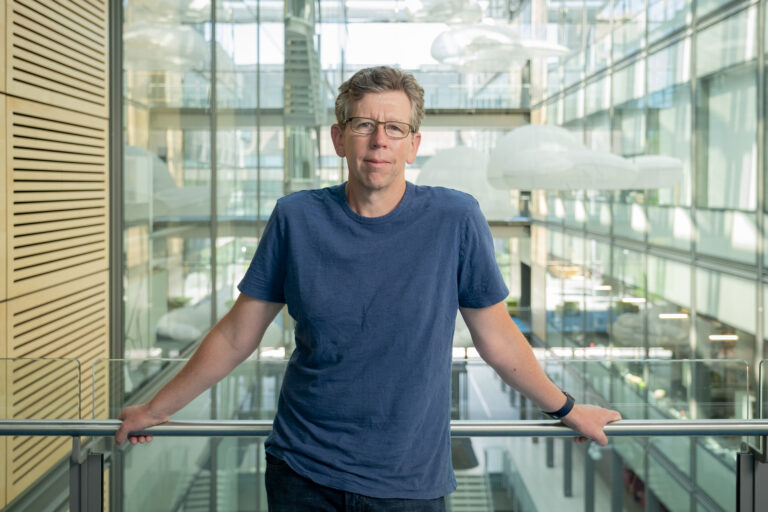
Tom Muir
Contact:
Tom Muir
Van Zandt Williams Jr. Class of 1965 Professor of Chemistry.
[email protected]
Frick Laboratory, 325
609-258-5778
Faculty Assistant:
Jodi Venables
Faculty / Grants Assistant
[email protected]
Frick Laboratory, 327
609-258-5705
Research Focus
The Muir lab investigates the physiochemical basis of protein function in complex systems of biomedical interest. We study protein function using an integration of synthetic organic and physical chemistry tools in combination with those of molecular genetics. Driven by a series of biological questions, we have developed general chemical biology approaches that allow the covalent structure of proteins to be manipulated with a similar level of control to those possible with smaller organic molecules. These technologies, which can be applied both in vitro and in vivo, allow the insertion of unnatural amino acids, posttranslational modifications and isotopic probes site-specifically anywhere into proteins. Our innovative methods are now used by numerous laboratories worldwide to address a large number of biomedical questions. A summary of ongoing work in the Muir group is provided below:
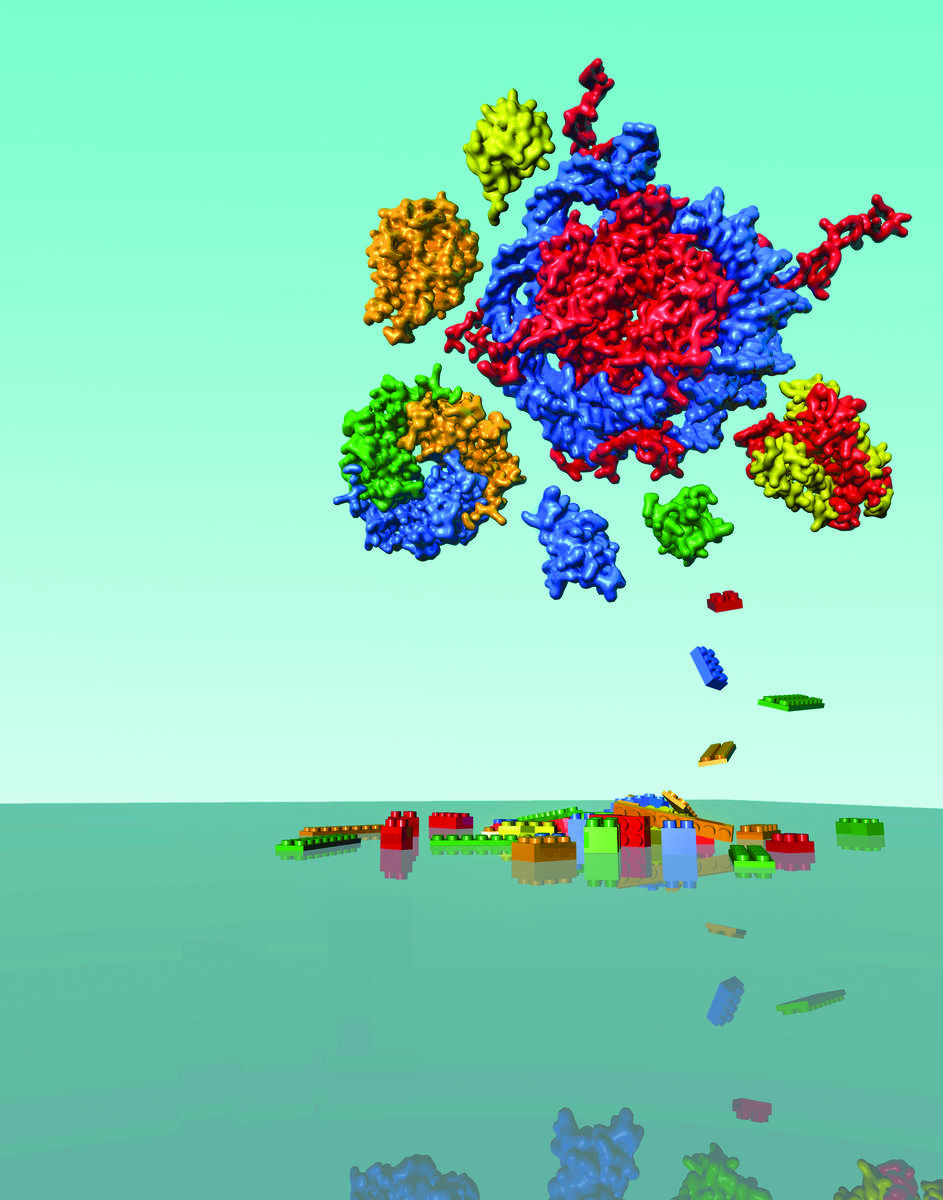
Chromatin
The eukaryotic genome is organized as a DNA-protein complex called chromatin. This architecture enables dynamic compaction of DNA within the confined space of the nucleus, and facilitates access to desired genomic loci through post-translational modification of scaffold proteins (histones). In the Muir lab, we use synthetic ‘designer’ chromatin to investigate the molecular basis of how histone modifications control DNA-templated processes and how aberrant chromatin signaling pathways contribute to pathologies.
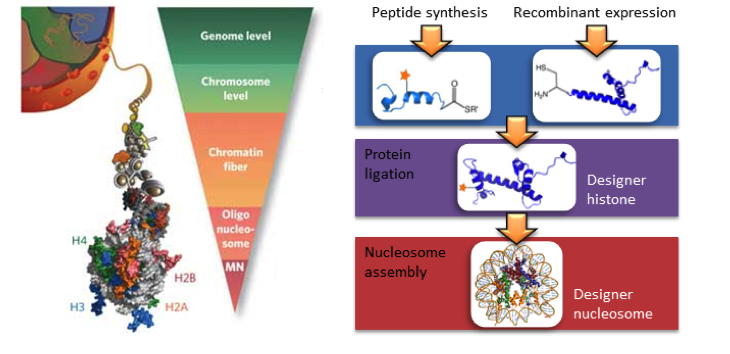
Schematic representation of genome architecture (left) and synthesis of ‘designer’ nucleosomes (right).
Some recent papers:
Lukasak, B.J.; Mitchener, M.M.; Kong, L.; Dul, B.E.; Lazarus, C.D.; Ramakrishnan, A.; Ni, J.; Shen, L;, Maze, I.; * Muir, T.W. “TGM2-Mediated Histone Transglutamination is Dictated by Steric Accessibility.” 2022. Proc. Natl. Acad. Sci. USA, 119(43). doi: 10.1073/pnas.220867211
Lukasak, B. J.*; Thompson, R. E.*; Mitchener, M. M.; Feng, V. J.; Bagert, J. D.; Muir, T. W. “A Genetically Encoded Approach for Breaking Chromatin Symmetry.” ACS. Cent. Sci. 2022. 8(2): 176-183. doi: 10.1021/acscentsci.1c01332
Mashtalir, N.*; Dao, H. T.*; Sankar, A.; Liu, H.; Corin, A.J.; Bagert, J. D.; Ge, E. J.; D’Avino, A. R.; Filipovski, M.; Michel, B. C.; Dann, G. P.; Muir, T. M.; Kadoch, C. “Chromatin landscape signals differentially dictate the activities of mSWI/SNF family complexes.” Science. 2021. 373(6552):306-315. doi: 10.1126/science.abf8705
Bagert, J. D., & Muir, T. W. “Molecular Epigenetics: Chemical Biology Tools Come of Age.” Annual Review of Biochemistry, 2021. 90(1), 287-320. doi:10.1146/annurev-biochem-080120-021109
Diehl, K.L.; Ge, E.J.; Weinberg, D.N.; Jani, K.S.; Allis, C.D.; Muir, T.W. “PRC2 engages a bivalent H3K27M-H3K27me3 dinucleosome inhibitor.” PNAS. 2019. 116, 44, 22152-22157. doi: 10.1073/pnas.1911775116
Beh, L.Y.; Debelouchina, G.T.; Clay, D.M.; Thompson, R.E.; Lindblad, K.A.; Hutton, E.R.; Bracht, J.R.; Sebra, R.P.; *Muir, T.W.; *Landweber, L.F. “Identification of a DNA N6-Adenine Methyltransferase Complex and Its Impact on Chromatin Organization.” Cell. 2019. 177, 1781–1796 doi: 10.1016/j.cell.2019.04.028
Farrelly, L.A.; Thompson, R.E.; Zhao, S.; Lepack, A.E.; Lyu, Y.; Bhanu, N.V.; Zhang, B.; Loh, Y.E.; Ramakrishnan, A.; Vadodaria, K.C.; Heard, K.J.; Erikson, G.; Nakadai, T.; Bastle, R.M.; Lukasak, B.J.; Zebroski, H. 3rd; Alenina, N.; Bader, M.; Berton, O.; Roeder, R.G.; Molina, H.; Gage, F.H.; Shen, L.; Garcia, B.A.; Li, H.; Muir, T.W.; Maze, I. “Histone serotonylation is a permissive modification that enhances TFIID binding to H3K4me3.” Nature. 2019, 567, 535-539. doi: 10.1038/s41586-019-1024-7
Liszczak, G.*; Diehl, K.L.*; Dann, G.P.; Muir, T.W. “Acetylation blocks DNA damage-induced chromatin ADP-ribosylation.” Nat. Chem. Biol. 2018, 14(9), 837-840. doi: 10.1038/s41589-018-0097-1
Debelouchina GT, Gerecht K, Muir TW. “Ubiquitin utilizes an acidic surface patch to alter chromatin structure.” Nat Chem Biol. 2017 Jan;13(1):105-110. doi: 10.1038/nchembio.2235
Oncohistones
Mutations in histone proteins, such as H3K27M, H3G34R/V, and H3K36M, have been associated with cancers. Recently, we and other researchers have uncovered thousands more cancer-associated histone mutations which remain largely uncharacterized. Using a cross-disciplinary, chemical biology approach, our lab seeks to dissect the molecular mechanisms by which these so-called “oncohistones” contribute to the development and progression of cancer.
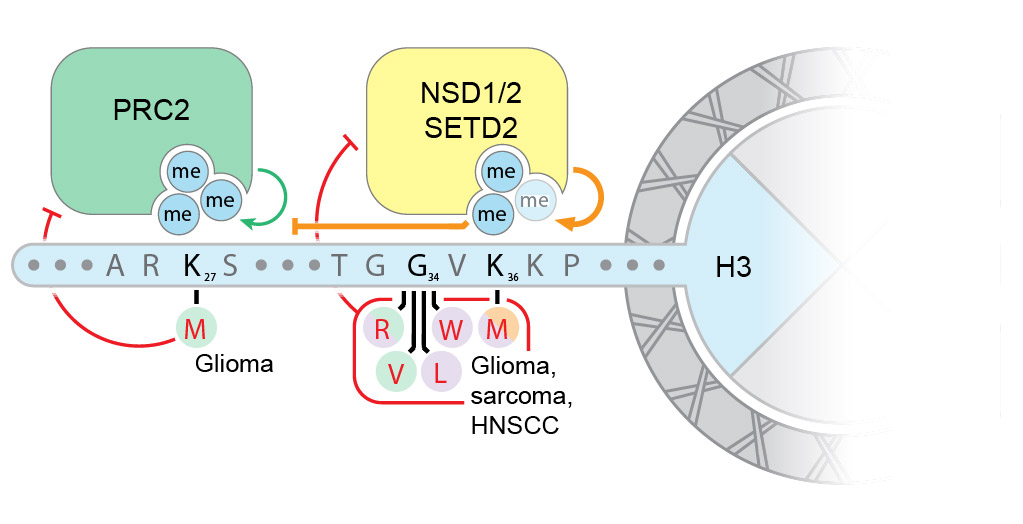
Some recent papers:
Dao, H. T.*; Liu, H.*; Mashtalir, N.; Kadoch, C.; Muir, T. W. “Synthesis of Oriented Hexasomes and Asymmetric Nucleosomes Using a Template Editing Process.” J. Am. Chem. Soc. 2022. 144(5): 2284-2291. doi: 10.1021/jacs.1c12420
Bagert JD*, Mitchener MM*, Patriotis AL**, Dul BE**, Wojcik F, Nacev BA, Feng L, Allis CD, Muir TW. “Oncohistone mutations enhance chromatin remodeling and alter cell fates.” Nat Chem Biol. 2021 Apr;17(4):403-411. doi: 10.1038/s41589-021-00738-1
Burton, A.J.; Haugbro, M.; Gates, L.A.; Bagert, J.D.; Allis, C.D.; Muir, T.W. “In situ chromatin interactomics using a chemical bait and trap approach.” Nat. Chem. 2020. 12, 520–527. doi: 10.1038/s41557-020-0474-8
Dao, H.T.; Dul, B.E.; Dann, G.P.; Liszczak, G.P.; Muir, T.W. “A basic motif anchoring ISWI to nucleosome acidic patch regulates nucleosome spacing.” Nat. Chem. Biol. 2020. 16, 134-142. doi: 10.1038/s41589-019-0413-4
Nacev, B.A.; Feng, L; Bagert, J.D.; Lemiesz, A.E; Gao, J.J.; Soshnev, A.A.; Kundra, R.; Schultz, N; Muir, T.W.; Allis, C.D. “The expanding landscape of ‘oncohistone’ mutations in human cancers.” Nature. 2019, 567, 473-478. doi: 10.1038/s41586-019-1038-1
Mitchener, M.M.; Muir, T.W. “Oncohistones: exposing the nuances and vulnerabilities of epigenetic regulation.” 2022. Molecular Cell, 82(16): 2925-2938. doi: 10.1016/j.molcel.2022.07.008
Inteins
Inteins, found in a variety of unicellular organisms, are polypeptide sequences that are able to excise themselves from flanking protein regions (exteins) and to ligate the exteins together. While the biological function of inteins remains a mystery, this class of proteins has found widespread use in the fields of chemical and cell biology. Recognizing the unique intein splicing reaction as a platform for the development of chemical biological tools, the Muir Lab aims to characterize the precise biochemical requirements for intein splicing and to engineer inteins with enhanced properties for the development of novel intein-based technologies.
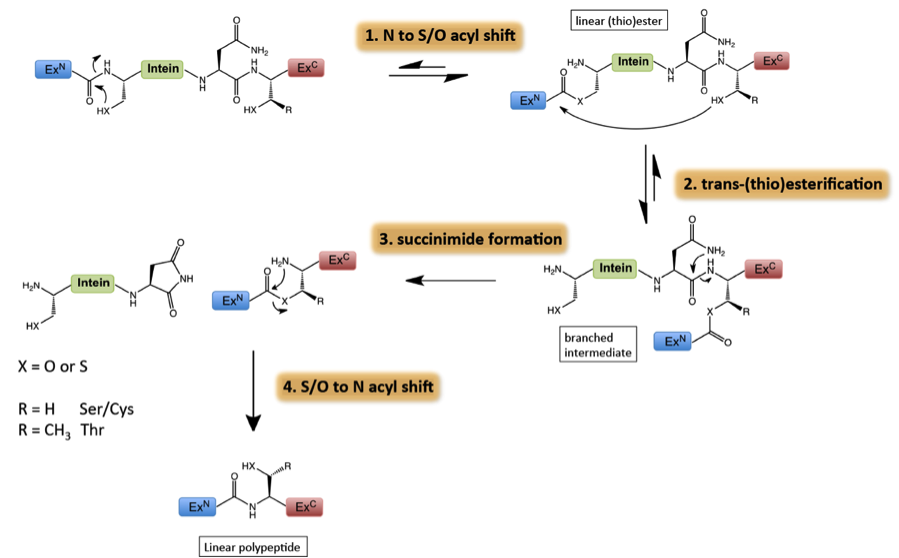
Mechanism of intein-mediated protein splicing.
Some recent papers:
Sekar, G.; Stevens, A.J.; Mostafavi, A.Z.; Sashi, P.; Muir, T.W.; Cowburn, D. “A conserved histidine residue drives extein dependence in an enhanced atypically split intein.” 2022. J. Am. Chem. Soc, 144(41): 19196-19203. doi: 10.1021/jacs.2c08985
Thompson, R.E.; Muir, T.W. “Chemoenzymatic Semisynthesis of Proteins.” Chem. Rev. 2020. doi: 10.1021/acs.chemrev.9b00450
Burton, A.J.*; Haugbro, M.*; Parisi, E.; Muir, T.W. “Live-cell protein engineering with an ultra-short split intein.” Proc. Natl. Acad. Sci. USA. 2020. 117(22), 12041–12049. doi: 10.1073/pnas.2003613117
Gramespacher, J.A.; Burton, A.J.; Guerra, L.F.; Muir, T.W. “Proximity Induced Splicing Utilizing Caged Split Inteins.” J. Am. Chem. Soc. 2019. 141, 35, 13708-13712. doi: 10.1021/jacs.9b05721
Thompson, R.E.; Stevens, A. J.; Muir, T.W. “Protein engineering through tandem transamidation.” Nature Chemistry. 2019. 11, 737-749. doi: 10.1038/s41557-019-0281-2
Agr
Bacteria communicate through small-molecule signals. A commensal pathogen, Staphylococcus aureus, secretes a peptide pheromone, AIP, which acts as an extracellular indicator of the population density and coordinates its virulence response. Production and sensing of AIP involves four Agr (accessory gene regulator) proteins. The Muir lab uses highly purified recombinant or synthetic components to reconstitute these processes and to investigate how each Agr protein carries out its function at the molecular level.
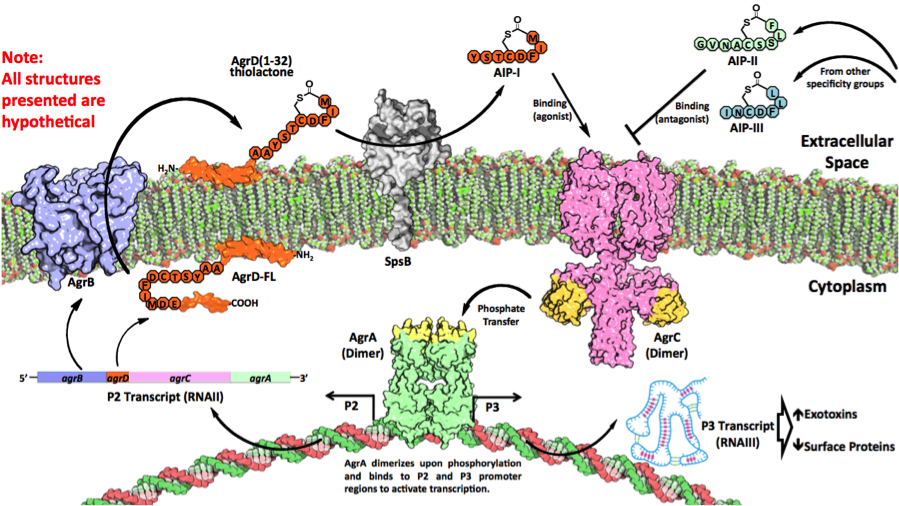
Schematic representation of the S. aureus quorum sensing pathway.
Some recent papers:
Zhao, A.; Bodine, S.P.; Xie, Q.; Wang, B.; Ram, G.; Novick, R.P.; *Muir, T.W. Reconstitution of the S. aureus agr quorum sensing pathway reveals a role for the membrane protease MroQ in pheromone biosynthesis. Proc. Natl. Acad. Sci. USA, 2022. 119(33). doi: 10.1073/pnas.2202661119
Xie, Q.; Wiedmann, M.M.; Zhao, A.; Pagan, I.R.; Novick, R.P.; Suga, H.; Muir, T.W. “Discovery of quorum quenchers targeting the membrane-embedded sensor domain of the Staphylococcus aureus receptor histidine kinase, AgrC.” Chem. Commun. 2020. 56(76), 11223-11226. doi: 10.1039/d0cc04873a
Xie, Q.; Zhao, A.; Jeffrey, P.D.; Kim, M.K.; Bassler, B.L.; Stone, H.A.; Novick, R.P.; Muir, T.W. “Identification of a Molecular Latch that Regulates Staphylococcal Virulence.” Cell Chem Biol. 2019, 26, 1-11. doi: 10.1016/j.chembiol.2019.01.006
Wang B, Zhao A, Xie Q, Olinares PD, Chait BT, Novick RP, Muir TW. Functional Plasticity of the AgrC Receptor Histidine Kinase Required for Staphylococcal Virulence. Cell Chem Biol. 2017 Jan 19;24(1):76-86. doi: 10.1016/j.chembiol.2016.12.008.
Honors
Ira Remsen Award, American Chemical Society (Maryland Division) (2022)
Election to the Royal Society (2021)
Election to the American Academy of Arts and Sciences (2020)
Emil Thomas Kaiser Award, The Protein Society (2017)
Winner of the Breslow Award in Biomimetic Chemistry from the American Chemical Society (2016)
Corresponding Fellow of The Royal Society of Edinburgh (2013)
Arthur C. Cope Scholar Award, American Chemical Society (2013)
Elected Fellow of the Royal Society of Chemistry (2012)
Jeremy Knowles Award, Royal Society of Chemistry (2012)
MERIT Award, US National Institutes of Health (2012)
Vincent du Vigneaud Award in Peptide Chemistry, American Peptide Society (2008)
Fellow of the American Association for the Advancement of Science (2007)
Kavli Fellow, U.S. National Academy of Sciences (2007)
Leonidas Zervas Award from The European Peptide Society (2002)
Alfred P. Sloan Research Fellow (2000)
Pew Scholar in the Biomedical Sciences (1998)
Selected Publications
Zhao, A.; Bodine, S.P.; Xie, Q.; Wang, B.; Ram, G.; Novick, R.P.; *Muir, T.W. Reconstitution of the S. aureus agr quorum sensing pathway reveals a role for the membrane protease MroQ in pheromone biosynthesis. Proc. Natl. Acad. Sci. USA, 2022. 119(33). doi: 10.1073/pnas.2202661119
Lukasak, B.J.; Mitchener, M.M.; Kong, L.; Dul, B.E.; Lazarus, C.D.; Ramakrishnan, A.; Ni, J.; Shen, L;, Maze, I.; * Muir, T.W. TGM2-Mediated Histone Transglutamination is Dictated by Steric Accessibility. 2022. Proc. Natl. Acad. Sci. USA, 119(43). doi: 10.1073/pnas.220867211
Mitchener, M.M.; Muir, T.W. Oncohistones: exposing the nuances and vulnerabilities of epigenetic regulation. 2022. Molecular Cell, 82(16): 2925-2938. doi: 10.1016/j.molcel.2022.07.008
Sekar, G.; Stevens, A.J.; Mostafavi, A.Z.; Sashi, P.; Muir, T.W.; Cowburn, D. A conserved histidine residue drives extein dependence in an enhanced atypically split intein. 2022. J. Am. Chem. Soc, 144(41): 19196-19203. doi: 10.1021/jacs.2c08985
Park, S.; Mitchener, M. M.; Dao, H. T.; Muir, T. W.; Ha, T. Biophysical driving forces of heterochromatin organization Biophys. J. 2022. 121(3): 159a. doi: 10.1016/j.bpj.2021.11.1926
Lukasak, B. J.*; Thompson, R. E.*; Mitchener, M. M.; Feng, V. J.; Bagert, J. D.; Muir, T. W. A Genetically Encoded Approach for Breaking Chromatin Symmetry. ACS. Cent. Sci. 2022. 8(2): 176-183. doi: 10.1021/acscentsci.1c01332
Dao, H. T.*; Liu, H.*; Mashtalir, N.; Kadoch, C.; Muir, T. W. Synthesis of Oriented Hexasomes and Asymmetric Nucleosomes Using a Template Editing Process. J. Am. Chem. Soc. 2022. 144(5): 2284-2291. doi: 10.1021/jacs.1c12420
Burton, A. J.; Hamza, G. M.; Zhang, A. X.; Muir, T. W. Chemical biology approaches to study histone interactors. Biochem. Soc. Trans. 2021. 49(5): 2431-2441. doi: 10.1042/BST20210772
Mitchener, M. M.; Muir, T. M. Janus Bioparticles: Asymmetric Nucleosomes and Their Preparation Using Chemical Biology Approaches. Acc. Chem. Res,2021. 54(16): 3215-3227. doi:doi.org/10.1021/acs.accounts.1c00313
Mashtalir, N.*; Dao, H. T.*; Sankar, A.; Liu, H.; Corin, A.J.; Bagert, J. D.; Ge, E. J.; D’Avino, A. R.; Filipovski, M.; Michel, B. C.; Dann, G. P.; Muir, T. M.; Kadoch, C. Chromatin landscape signals differentially dictate the activities of mSWI/SNF family complexes. Science. 2021. 373(6552):306-315. doi: 10.1126/science.abf8705.
Hanaya, N.; Daley, S.; Bagert, J. D.; Muir, T. W.; Synthesis of ADP-Ribosylated Histones Reveals Site-Specific Impacts on Chromatin Structure and Function. J. Am. Chem. Soc. 2021. 143(29): 10847-10852. doi: doi.org/10.1021/jacs.1c05429.
Wu, A.; Zhi, J.; Tian, T.; Cihan, A.; Cevher, M. A.; Liu, Z.; David, Y.; Muir, T. W.; Roeder, R. G.; Yu, M. DOT1L complex regulates transcriptional initiation in human erythroleukemic cells. Proc Natl Acad Sci U S A. 2021. 118(27), e2106148118. doi:10.1073/pnas.2106148118
Bagert, J. D., & Muir, T. W. Molecular Epigenetics: Chemical Biology Tools Come of Age. Annual Review of Biochemistry, 2021. 90(1), 287-320. doi:10.1146/annurev-biochem-080120-021109
Naismith JH, Song H, Burton AJ, Shirran SL, Fahrig-Kamarauskaitė J, Kaspar H, Muir TW, Künzler M. Engineering of a peptide α-N-methyltransferase to methylate non-proteinogenic amino acids. Angew Chem Int Ed Engl. 2021 Apr 15. doi: 10.1002/anie.202100818
Bagert JD*, Mitchener MM*, Patriotis AL**, Dul BE**, Wojcik F, Nacev BA, Feng L, Allis CD, Muir TW. Oncohistone mutations enhance chromatin remodeling and alter cell fates. Nat Chem Biol. 2021 Apr;17(4):403-411. doi: 10.1038/s41589-021-00738-1
Zhao S*, Chuh KN*, Zhang B, Dul BE, Thompson RE, Farrelly LA, Liu X, Xu N, Xue Y, Roeder RG, Maze I, Muir TW, Li H. Histone H3Q5 serotonylation stabilizes H3K4 methylation and potentiates its readout. Proc Natl Acad Sci U S A. 2021 Feb 9;118(6):e2016742118. doi: 10.1073/pnas.2016742118
Seath CP , Trowbridge AD , Muir TW , MacMillan DWC . Reactive intermediates for interactome mapping. Chem Soc Rev. 2021 Mar 7;50(5):2911-2926. doi: 10.1039/d0cs01366h
Leicher, R.; Ge, E.J.; Lin, X.; Reynolds, M.J.; Xie, W.; Walz, T.; Zhang, B.; Muir, T.W.; Liu, S. “Single-molecule and in silico dissection of the interaction between Polycomb repressive complex 2 and chromatin.” Proc Natl Acad Sci USA. 2020. 117(48) 30465-30475. doi: 10.1073/pnas.2003395117
Xu, G.; van Bruggen, R.; Gualtieri, C.O.; Moragin, N.; Fois, A.; Vallerand, D.; De Sa Tavares Russo, M.; Bassenden, A.; Lu, W.; Tam, M.; Lesage, S.; Girouard, H.; Avizonis, D.Z.; Deblois, G.; Prchal, J.T.; Stevenson, M.; Berghuis, A.; Muir, T.W.; Rabinowitz, J.D.; Vidal, S.M.; Fodil, N.; Gros, P. “Bisphosphoglycerate Mutase Deficiency Protects against Cerebral Malaria and Severe Malaria-Induced Anemia.” Cell Rep. 2020. 32(12), 108170. doi: 10.1016/j.celrep.2020.108170
Xie, Q.; Wiedmann, M.M.; Zhao, A.; Pagan, I.R.; Novick, R.P.; Suga, H.; Muir, T.W. “Discovery of quorum quenchers targeting the membrane-embedded sensor domain of the Staphylococcus aureus receptor histidine kinase, AgrC.” Chem. Commun. 2020. 56(76), 11223-11226. doi: 10.1039/d0cc04873a
McBride, M.J.*; Mashtalir, N.*; Winter, E.B.; Dao, H.T.; Filipovski, M.; D’Avino, A.R.; Seo, H.S.; Umbreit, N.T.; St. Pierre, R.; Valencia, A.M.; Qian, K.; Zullow, H.J.; Jaffe, J.D.; Dhe-Paganon, S.; Muir, T.W.; Kadoch, C. “The nucleosome acidic patch and H2A ubiquitination underlie mSWI/SNF recruitment in synovial sarcoma.” Nat Struct. Mol. Biol. 2020. 27(9), 836-845. doi: 10.1038/s41594-020-0466-9
Burton, A.J.; Haugbro, M.; Gates, L.A.; Bagert, J.D.; Allis, C.D.; Muir, T.W. In situ chromatin interactomics using a chemical bait and trap approach. Nat. Chem. 2020. 12, 520–527. doi: 10.1038/s41557-020-0474-8
Diehl, K.L.; Muir, T.W. “Chromatin as a key consumer in the metabolite economy.” Nat. Chem. Biol. 2020. 16, 620–629. doi: 10.1038/s41589-020-0517-x
Burton, A.J.*; Haugbro, M.*; Parisi, E.; Muir, T.W. “Live-cell protein engineering with an ultra-short split intein.” Proc. Natl. Acad. Sci. USA. 2020. 117(22), 12041–12049. doi: 10.1073/pnas.2003613117
Kwon, M.; Park, K.; Hyun, K.; Lee, J.H.; Zhou, L.; Cho, Y.W.; Ge, K.; Skalnik, D.G.; Muir, T.W.; Kim, J. “H2B ubiquitylation enhances H3K4 methylation activities of human KMT2 family complexes.” Nucleic Acids Res. 2020. 48(10), 5442–5456. doi: 10.1093/nar/gkaa317
Wan, L.; Chong, S.; Xuan, F.; Liang, A.; Cui, X.; Gates, L.; Carroll, T.S.; Li, Y.; Feng, L.; Chen, G.; Wang, S.P.; Ortiz, M.V.; Daley, S.K.; Wang, X.; Xuan, H.; Kentsis, A.; Muir, T.W.; Roeder, R.G.; Li, H.; Li, W.; Tjian, R.; Wen, H.; Allis, C.D. “Impaired cell fate through gain-of-function mutations in a chromatin reader.” Nature. 2020. 577(7788), 121-126. doi: 10.1038/s41586-019-1842-7
Murawska, M.; Schauer, T.; Matsuda, A.; Wilson, M.D.; Pysik, T.; Wojcik, F.; Muir, T.W.; Hiraoka, Y.; Straub, T.; Ladurner, A.G. “The Chaperone FACT and Histone H2B Ubiquination Maintain S. pombe Genome Architecture through Genic and Subtelomeric Functions.” Mol. Cell. 2020. 77(3), 501-513.e7. doi: 10.1016/j.molcel.2019.11.016
Dao, H.T.; Dul, B.E.; Dann, G.P.; Liszczak, G.P.; Muir, T.W. “A basic motif anchoring ISWI to nucleosome acidic patch regulates nucleosome spacing.” Nat. Chem. Biol. 2020. 16, 134-142. doi: 10.1038/s41589-019-0413-4
Thompson, R.E.; Muir, T.W. “Chemoenzymatic Semisynthesis of Proteins.” Chem Rev. 2020. 120(6), 3051-3126. doi: 10.1021/acs.chemrev.9b00450
Albig, C.; Wang, C.; Dann, G.P.; Wojcik, F.; Schauer, T.; Krause, S.; Maenner, S.; Cai, W.; Li, Y.; Girton, J.; Muir, T.W.; Johansen, H.; Johansen, K.M.; Becker, P.B.; Regnard, C. “JASPer controls interphase histone H3S10 phosphorylation by chromosomal kinase JIL-1 in Drosophila.” Nat. Commun. 2019. 10(1), 5343. doi: 10.1038/s41467-019-13174-6
Valencia, A.M.; Collings, C.K.; Dao, H.T.; St. Pierre, R.; Cheng, Y.-C.; Huang, J.; Sun, Z.-Y.; Seo, H.-S.; Mashtalir, Nazar; Comstock, D.E.; Bolonduro, O.; Vangos, N.E.; Yeoh, Z.C.; Dornan, M.K.; Hermawan, C.; Barrett, L.; Dhe-Paganon, S.; Woolf, C.J.; Muir, T.W.; Kadoch, C. “Recurrent SMARCB1 Mutations Reveal a Nucleosome Acidic Patch Interaction Site That Potentiates mSWI/SNF Complex Chromatin Remodeling.” Cell. 2019. 179, 1342–1356. doi: 10.1016/j.cell.2019.10.044
Diehl, K.L.; Ge, E.J.; Weinberg, D.N.; Jani, K.S.; Allis, C.D.; Muir, T.W. “PRC2 engages a bivalent H3K27M-H3K27me3 dinucleosome inhibitor.” PNAS. 2019. 116, 44, 22152-22157. doi: 10.1073/pnas.1911775116
Ge, E.J.; Jani, K.S.; Diehl, K.L.; Muller, M.M.; Muir, T.W. “Nucleation and Propagation of Heterochromatin by the Histone Methyltransferase PRC2: Geometric Constraints and Impact of the Regulatory Subunit JARID2.” J. Am. Chem. Soc. 2019. 141, 38, 15029-15039. doi: 10.1021/jacs.9b02321
Gramespacher, J.A.; Burton, A.J.; Guerra, L.F.; Muir, T.W. “Proximity Induced Splicing Utilizing Caged Split Inteins.” J. Am. Chem. Soc. 2019. 141, 35, 13708-13712. doi: 10.1021/jacs.9b05721
Guerra, L.F.; Muir, T.W.; Yang, H. “Single-Particle Dynamic Light Scattering: Shapes of Individual Nanoparticles.” Nano Lett. 2019. 19(8), 5530-5536. doi: 10.1021/acs.nanolett.9b02066
Thompson, R.E.; Stevens, A. J.; Muir, T.W. “Protein engineering through tandem transamidation.” Nature Chemistry. 2019. 11, 737-749. doi: 10.1038/s41557-019-0281-2
Beh, L.Y.; Debelouchina, G.T.; Clay, D.M.; Thompson, R.E.; Lindblad, K.A.; Hutton, E.R.; Bracht, J.R.; Sebra, R.P.; Muir, T.W.; Landweber, L.F. “Identification of a DNA N6-Adenine Methyltransferase Complex and Its Impact on Chromatin Organization.” Cell. 2019. 177, 1781–1796 doi: 10.1016/j.cell.2019.04.028
Jain, S.U.; Do, T.J.; Lund, P.J.; Rashoff, A.Q.; Diehl, K.L.; Cieslik, M; Bajic, A.; Juretic, N.; Deshmukh, S.; Venneti, S.; Muir, T.W.; Garcia, B.A.; Jabado, N.; Lewis, P.W. “PFA ependymoma-associated protein EZHIP inhibits PRC2 activity through a H3 K27M-like mechanism.” Nat. Commun. 2019. doi: 10.1038/s41467-019-09981-6
Jani, K.S.; Jain, S.U.; Ge, E.J.; Diehl, K.L.; Lundgren, S.M.; Müller, M.M.; Lewis, P.W.; Muir, T.W. “Histone H3 tail binds a unique sensing pocket in EZH2 to activate the PRC2 methyltransferase.” PNAS. 2019, 116 (17), 8295-8300. doi: 10.1073/pnas.1819029116
Nacev, B.A.; Feng, L; Bagert, J.D.; Lemiesz, A.E; Gao, J.J.; Soshnev, A.A.; Kundra, R.; Schultz, N; Muir, T.W.; Allis, C.D. “The expanding landscape of ‘oncohistone’ mutations in human cancers.” Nature. 2019, 567, 473-478. doi: 10.1038/s41586-019-1038-1
Farrelly, L.A.; Thompson, R.E.; Zhao, S.; Lepack, A.E.; Lyu, Y.; Bhanu, N.V.; Zhang, B.; Loh, Y.E.; Ramakrishnan, A.; Vadodaria, K.C.; Heard, K.J.; Erikson, G.; Nakadai, T.; Bastle, R.M.; Lukasak, B.J.; Zebroski, H. 3rd; Alenina, N.; Bader, M.; Berton, O.; Roeder, R.G.; Molina, H.; Gage, F.H.; Shen, L.; Garcia, B.A.; Li, H.; Muir, T.W.; Maze, I. “Histone serotonylation is a permissive modification that enhances TFIID binding to H3K4me3.” Nature. 2019, 567, 535-539. doi: 10.1038/s41586-019-1024-7
Xie, Q.; Zhao, A.; Jeffrey, P.D.; Kim, M.K.; Bassler, B.L.; Stone, H.A.; Novick, R.P.; Muir, T.W. “Identification of a Molecular Latch that Regulates Staphylococcal Virulence.” Cell Chem Biol. 2019, 26, 1-11. doi: 10.1016/j.chembiol.2019.01.006
Liszczak, G. and Muir, T.W. “Nucleic Acid-Barcoding Technologies: Converting DNA Sequencing into a Broad-Spectrum Molecular Counter.” Angew Chem Int Ed. 2019, 58, 2-21. doi: 10.1002/anie.201808956
Related News

Muir Earns Enzyme Chemistry Award from ACS
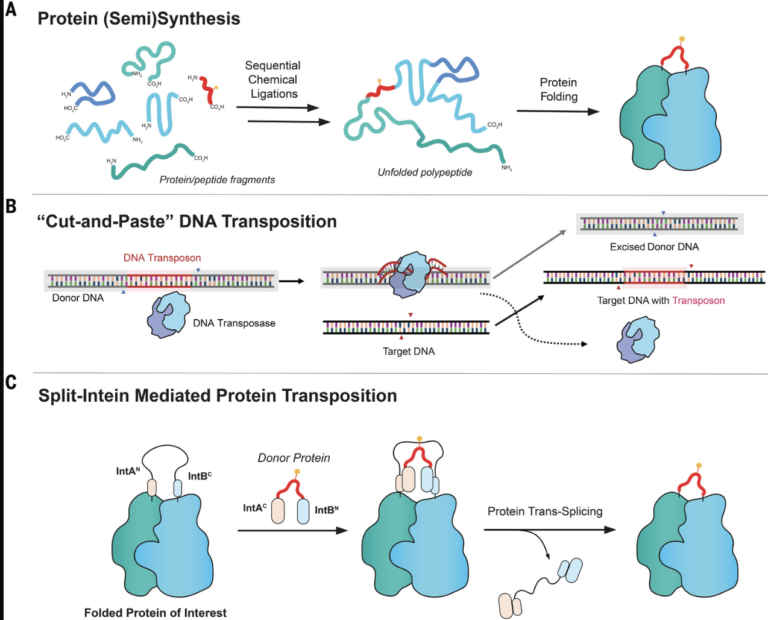
Muir Lab Introduces a Groundbreaking Method for Protein Editing
